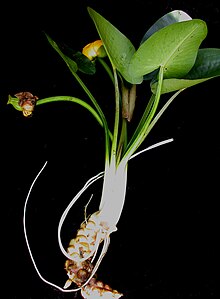
Nymphaeaceae is a family of flowering plants, commonly called water lilies. They live as rhizomatous aquatic herbs in temperate and tropical climates around the world. The family contains five genera with about 70 known species. Water lilies are rooted in soil in bodies of water, with leaves and flowers floating on or rising from the surface. Leaves are oval and heart-shaped in Barclaya. Leaves are round, with a radial notch in Nymphaea and Nuphar, but fully circular in Victoria and Euryale.

Victoria or giant waterlily is a genus of aquatic herbs in the plant family Nymphaeaceae. Its leaves have a remarkable size: Victoria boliviana produces leaves up to 3.2 metres (10 ft) in width. The genus name was given in honour of Queen Victoria of the United Kingdom.
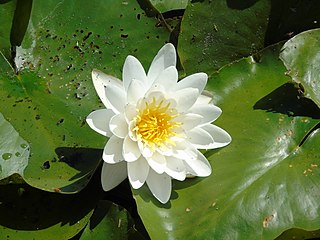
Nymphaea is a genus of hardy and tender aquatic plants in the family Nymphaeaceae. The genus has a cosmopolitan distribution. Many species are cultivated as ornamental plants, and many cultivars have been bred. Some taxa occur as introduced species where they are not native, and some are weeds. Plants of the genus are known commonly as water lilies, or waterlilies in the United Kingdom. The genus name is from the Greek νυμφαία, nymphaia and the Latin nymphaea, which means "water lily" and were inspired by the nymphs of Greek and Latin mythology.

Nuphar is a genus of aquatic plants in the family Nymphaeaceae, with a temperate to subarctic Northern Hemisphere distribution. Common names include water-lily, pond-lily, alligator-bonnet or bonnet lily, and spatterdock.

Nuphar lutea, the yellow water-lily, brandy-bottle, or spadderdock, is an aquatic plant of the family Nymphaeaceae, native to northern temperate and some subtropical regions of Europe, northwest Africa, and western Asia. This species was used as a food source and in medicinal practices from prehistoric times with potential research and medical applications going forward.

Nuphar advena is a species of Nuphar native throughout the eastern United States and in some parts of Canada, such as Nova Scotia, as well as Mexico and Cuba. It is locally naturalized in Britain.

Nymphaea mexicana is a species of aquatic plant that is native to the Southern United States and Mexico as far south as Michoacán. Common names include yellow water lily, Mexican water lily and banana water lily.
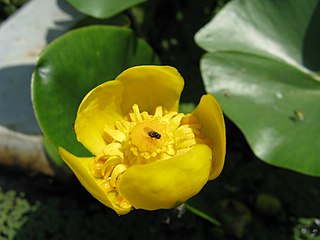
Nuphar pumila, the least water-lily, is a perennial, rhizomatous, aquatic herb in the family Nymphaeaceae native to subarctic and temperate Eurasia.

Nuphar polysepala, also known as the great yellow pond-lily, wokas, or wocus, is a perennial, rhizomatous, aquatic herb in the genus Nuphar native to western North America. It is commonly found in shallow muddy ponds from northern Alaska and Yukon southward to central California and northern New Mexico, and can be recognized easily by its large floating leaves and bright yellow blossoms.
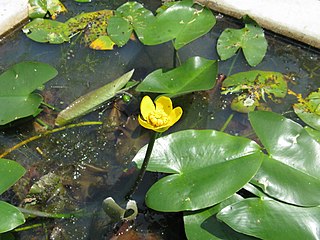
Nuphar japonica, known as East Asian yellow water-lily, is a perennial, aquatic, rhizomatous, herb in the family Nymphaeaceae native to Japan, Korea, and Russia.

Nuphar sagittifolia, common name arrow-leaved water-lily or Cape Fear spatterdock, is a plant species known only from North Carolina, South Carolina, and Virginia.

Nuphar carlquistii is an extinct species of flowering plant in the family Nymphaeaceae related to the modern spatterdock, Nuphar advena. The species is known from fossil seeds and fruits found in the early Eocene Okanagan Highlands deposits of northern Washington state and British Columbia, Canada.

Nymphaea tetragona is an aquatic perennial, species of flowering plant commonly called pygmy waterlily and small white water lily, belonging to the family Nymphaeaceae.

Nuphar microphylla is a perennial, rhizomatous, aquatic herb found in North America. It is listed as a special concern and believed extirpated in Connecticut.
Nuphar orbiculata is a species of rhizomatous aquatic plant native to the US-American states Alabama, Florida, and Georgia.

Nuphar × porphyranthera is a species of rhizomatous aquatic plant native to Great Britain. It is a hybrid of Nuphar lutea and Nuphar advena.
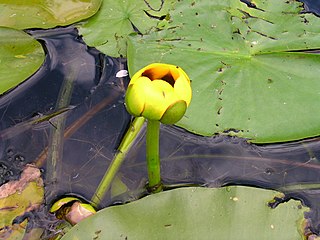
Nuphar × rubrodisca is a species of rhizomatous aquatic plant native to Canada and the USA. It is a natural hybrid of Nuphar variegata and Nuphar microphylla.

Nuphar pumila subsp. sinensis is a subspecies of Nuphar pumila native to China.

Nuphar sect. Astylus is a section within the genus Nuphar native to North America.

Nuphar sect. Nuphar is a section within the genus Nuphar native to Eurasia, in addition to a single North American species Nuphar microphylla.




